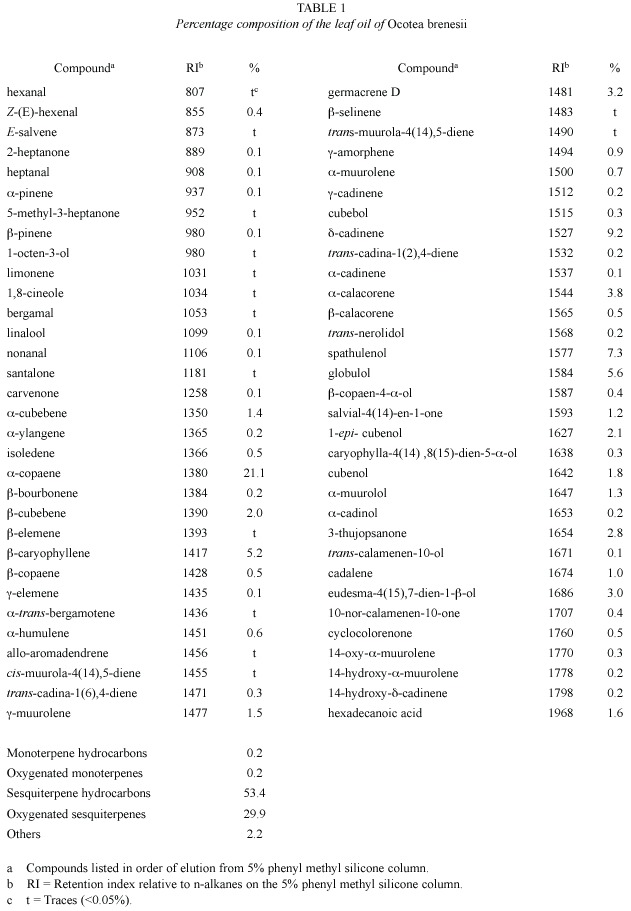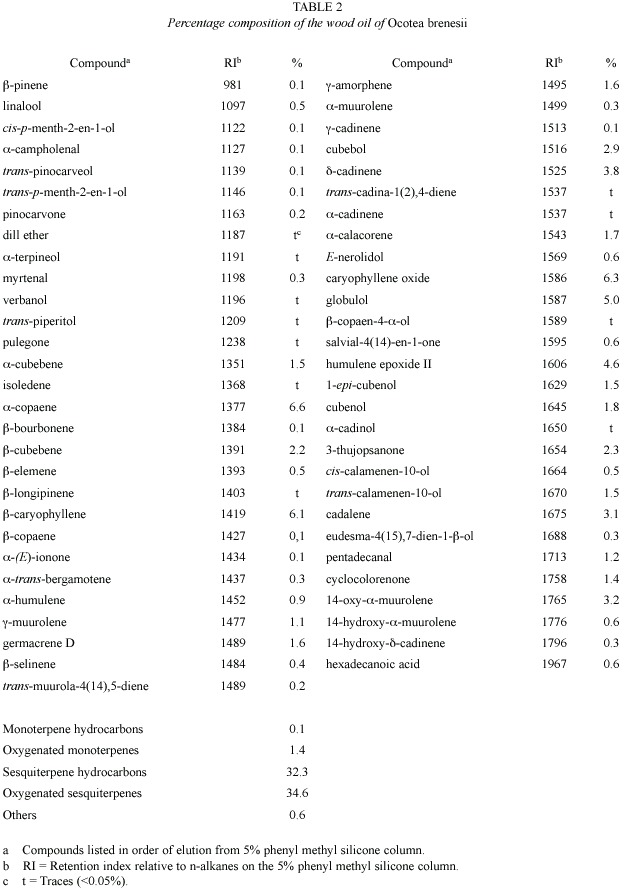Services on Demand
Journal
Article
Indicators
-
 Cited by SciELO
Cited by SciELO -
 Access statistics
Access statistics
Related links
-
 Similars in
SciELO
Similars in
SciELO  uBio
uBio
Share
Revista de Biología Tropical
On-line version ISSN 0034-7744Print version ISSN 0034-7744
Rev. biol. trop vol.53 n.3-4 San José Sep. 2005
Essential oil of trees of the genus Ocotea (Lauraceae) in Costa Rica. I. Ocotea brenesii
Carlos Chaverri & José F. Cicció*
Centro de Investigaciones en Productos Naturales (CIPRONA), Escuela de Química, Universidad de Costa Rica, 2060 San José, Costa Rica; * jfciccio@equi.ucr.ac.cr y cchaverri@formuquisa.com
Received 08-I-2005. Corrected 22-VII-2005. Accepted 05-IX-2005.
Abstract: The chemical composition of the essential oils from leaves and wood of Ocotea brenesii Standl. growing wild in Costa Rica was determined by capillary GC/FID and GC/MS. From the leaves, 4 compounds were identified, corresponding to 85.9% of the oil, and from the wood 57 compounds were identified corresponding to 69.0% of the oil. The major constituents identified in the leaf oil were 




Key words: Ocotea brenesii, Lauraceae, essential oils composition, 


The Lauraceae is a family of about 2000- 2200 species of mostly tropical trees. The family is an important component of cloud forests in Costa Rica where they occur in high abundance and diversity (Burger and van der Werff 1990, Haber 1996). This family is recognized by the simple, alternate, stiff and aromatic elliptic to obovate leaves, and by the fruits often borne in a cup.
Ocotea is a genus of 300-400 species growing mainly in the American tropics. The genus Ocotea belongs to the family Lauraceae and it is the largest genus of this family in Mesoamerica with 102 species (van der Werff 2002).
Ocotea brenesii is a tree of evergreen montane forest formations, from 700 to 2000 m elevation. The geographic distribution in Costa Rica ranges from near the "Alberto M. Brenes" Biological Preserve, San Ramón, to the area between Poás and Barva volcanoes in Alajuela Province (Burger and van der Werff 1990) and also is reported in Panama (van der Werff 2002). O. brenesii is recognized by the relatively broad leaves with a few secondary veins that appear thin in texture and dark in color when dry. Also it is characterized by racemose inflorescences and appressed indumenta on the young twigs (van der Werff 2002).
Chemically, the genus Ocotea is known mainly as a source of neolignans and benzyl-isoquinoline alkaloids (Gottlieb 1974, Franca et al. 1975, Ishige et al. 1991, Castro 1993, López et al. 1995). The chemical composition of the oils of some species belonging to this genus has been the subject of several studies (Mors 1959, Gottlieb and Magalhães 1960, Gottlieb et al. 1960a, 1960b, Brooks and Campbell 1969, Gottlieb et al. 1981, de Díaz et al. 1991, Terreaux et al. 1994, Reynolds and Kite 1995, Lorenzo et al. 2001, Bruni et al. 2004).
Previously, from the leaf of Ocotea brenesii, from Costa Rica, the isoquinoline alkaloids (+)-isocorydine, (-)-3-hydroxynuciferine and 3-hydroxy-6a,7-dehydronuciferine have been isolated (Lopez et al. 1996).
To the best of our knowledge no previous reports on the chemical composition of the oils of O. brenesii have been published.
Materials and methods
Fresh leaves and twigs of Ocotea brenesii Standl. [Syn: Nectandra brenesii (Standl.) C. K. Allen], Lauraceae, growing wild in Costa Rica were collected in April 2001, in San Ramón, Bajo Los Rodríguez, Province of Alajuela, Costa Rica. A voucher specimen was deposited at the Herbarium of the University of Costa Rica at the School of Biology (USJ 45808).
The leaves and dried wood were subject to hydrodistillation for 3 h using a modified Clevenger-type apparatus. The distilled oils were collected and dried over anhydrous sodium sulphate and stored in a freezer (0-10°C). The yield of the colorless oil from the leaf was 0.06% (v/w) and from the wood 0.02% (v/w).
The oils of O. brenesii were analyzed by GC/FID using a Shimadzu GC-17 gas chromatograph. The data were obtained on a 5% phenyl methylpolysiloxane fused silica capillary column (30 m x 0.25 mm; film thickness 0.20 µm), Heliflex (Alltech) AT-5, with a Shimadzu Class-VP, version 4.3 software.
Operating conditions were: carrier gas N2, flow 1.0 mL/min; oven temperature program: 60-220°C at 3°C/min, 220°C (10 min); sample injection port temperature 250°C; detector temperature 275°C; split 1:50.
The analysis by GC/MS was performed using a Shimadzu GC-17A gas chromatograph coupled with GCMS-QP5050 apparatus and CLASS 5000 software with Wiley138 computer database. The data were obtained on a 5% phenyl methylpolysiloxane fused silica capillary column (30 m x 0.25 mm; film thickness 0.25 µm). Operating conditions were: carrier gas He, flow 1.0 mL/min; oven temperature
program: 60-240°C at 3°C/min; sample injection port temperature 250°C; detector temperature 260°C; ionization voltage: 70eV; ionization current 60 µA; scanning speed 0.5 s over 38-400 amu range; split 1:70.
Identification of the components of the oils were performed using the retention indices on DB-5 type column, and by comparison of their mass spectra with those published in the literature (McLafferty 1993, Adams 1995, 2001) or those of our own database. Integration of the total chromatogram, expressed as area percent, has been used to obtain quantitative compositional data.
Results
The chemical compositions of the leaf and wood oils of O. brenesii are presented in Tables 1 and 2. As it can be observed, 64 components were identified from leaves, representing ca. 86% of the oil. Sesquiterpenic hydrocarbons were the main constituents (53.4%) of the oil and contained 




From the wood, 57 compounds were identified, representing ca. 70% of the oil. The oxygenated sesquiterpenes (34.6%) and sesquiterpenic hydrocarbons (32.3%) are the principal constituents identified. The main oxide (6.3%), 
Discussion
There are several reports on the composition of the oils of plants of the genus Ocotea from South America (Mors 1959, Gottlieb and Magalhães 1960, Gottlieb et al. 1960a, 1960b, Brooks and Campbell 1969, Gottlieb et al. 1981, de Díaz et al. 1991, Reynolds and Kite 1995, Lorenzo et al. 2001, Bruni et al. 2004) and Africa (Terreaux et al. 1994, Menut et al. 2002). The majority of them are characterized by the presence of phenylpropanoids like safrole and O-methyleugenol, cinnamaldehydes and some other benzenoid derivatives. The results obtained in this study showed that the oils of O. brenesii are characterized by compounds of terpenic chemical nature and are lacking of phenylpropanoids or benzenoid constituents that are typical of the majority of the Ocotea essential oils investigated previously.
Acknowledgments
The authors are grateful to Vicerrectoría de Investigación (UCR) (Project 809-A4-006) for financial support, to L. J. Poveda (Escuela de Ciencias Ambientales, UNA, Heredia) for the botanical identification, to L. Hernández (CIPRONA) for her technical assistance and to N. R. Farnsworth (College of Pharmacy, University of Illinois, USA at Chicago) for his help to access the NAPRALERT database.
Resumen
Se determinó la composición química de los aceites esenciales obtenidos de las hojas y de la madera del árbol Ocotea brenesii Standl., perteneciente a la familia Lauraceae, que crece en forma silvestre en Costa Rica. Para el estudio se utilizaron técnicas de cromatografía de gases capilar con detector de ionización de flama (GC/FID) y cromatografía de gases capilar acoplada a un detector de espectrometría de masas (GC/MS). Del aceite volátil de las hojas fueron identificados 64 constituyentes, que correspondieron a un 85.9% del aceite. Del aceite de la madera se identificaron 57 compuestos que correspondieron a un 69.0% del aceite. Los constituyentes mayoritarios que se identificaron en el aceite de las hojas fueron 



Palabras clave: Ocotea brenesii, Lauraceae, aceites esenciales, composición, 


References
Adams, R.P. 1995. Identification of Essential Oil Components by Gas Chromatography/Mass Spectroscopy. Allured, Carol Stream, Illinois, USA. 475 p. [ Links ]
Adams, R.P. 2001. Identification of Essential Oil Components by Gas Chromatography / Quadrupole Mass Spectroscopy. Allured, Carol Stream, Illinois, USA. 462 p. [ Links ]
Brooks, C.J. W. & M.M. Campbell. 1969. Caparrapi oxide, a new sesquiterpenoid from caparrapi oil. Phytochemistry 8: 215-218. [ Links ]
Bruni, R., A. Medici, E. Andreotti, C. Fantin, M. Muzzoli, M. Dehesa, C. Romagnoli & G. Sacchetti. 2004. Chemical composition and biological activities of Ishpingo essential oil, a traditional Ecuadorian spice from Ocotea quixos (Lam.) Kosterm. (Lauraceae) flower calices. Food Chem. 85: 415-421. [ Links ]
Burger, W. & H. van der Werff. 1990. Lauraceae. In Flora costaricensis. Fieldiana, Bot., n.s. 23: 1-129. [ Links ]
Castro, O.C. 1993. Chemical and biological extractives of Lauraceae species in Costa Rican tropical forests, pp. 65-87. In K. R. Downum, J. T. Romeo & H. A. Stafford (eds.). Phytochemical Potential of Tropical Plants. Plenum, New York, New York, USA. [ Links ]
de Díaz, A.M.P., P.P. Díaz & P. Joseph-Nathan. 1991. C6- C3 and C6C1 metabolites from the essential oil of the wood bark of Ocotea caparrapi. Rev. Latinoamer. Quím. 22: 60-62. [ Links ]
Franca, N.C., A.M. Giesbrecht, O.R. Gottlieb, A.F. Magalhães, E.G. Magalhães & J.G.S. Maia. 1975. Chemistry of Brazilian Lauraceae. Part 32. Benzylisoquinolines from Ocotea species. Phytochemistry 14: 1671-1672. [ Links ]
Gottlieb, O.R. 1974. Lignans and neolignans. Rev. Latinoamer. Quím. 5: 1-11. [ Links ]
Gottlieb, O.R. & M.T. Magalhães. 1960. Physiological varieties of Ocotea pretiosa. II. Perfum. Essent. Oil Rec. 51: 18-21. [ Links ]
Gottlieb, O.R., M. Fineberg and M.T. Magalhães. 1960a. Physiological varieties of Ocotea pretiosa. III. Perfum. Essent. Oil Rec. 53: 219-221. [ Links ]
Gottlieb, O.R., M. Fineberg & M.T. Magalhães. 1960b. Physiological varieties of Ocotea pretiosa. IV. Perfum. Essent. Oil Rec. 53: 299-301. [ Links ]
Gottlieb, O.R., M. Koketsu, M.T. Magalhães, S.M.J. Guilherme, P.H. Mendes, A.I. Da Rocha, M.L. Da Silva & V.C. Wilberg. 1981. Óleos esenciais da Amazônia VII. Acta Amazonica 11: 143-148. [ Links ]
Haber, W.A., W. Zuchowski & E. Bello. 1996. An introduction to Cloud forest trees: Monteverde, Costa Rica. La Nación (newspaper), San José, Costa Rica. 204 p. [ Links ]
Ishige, M., M. Motidome, M. Yoshida & O.R. Gottlieb. 1991. Neolignans from Ocotea catharinensis. Phytochemistry 30: 4121-4128. [ Links ]
López, J.A., W. Barillas, J. Gómez-Laurito, F.T. Lin, A.J. Al-Rehaily, M.H.M. Sharaf & P.L. Schiff Jr. 1995. Aporphine alkaloids of selected species of Nectandra and Ocotea. Planta Med. 61: 589. [ Links ]
López, J.A., W. Barillas, J. Gómez-Laurito, F.T. Lin, A.J. Al-Rehaily, M.H.M. Sharaf & P.L. Schiff Jr. 1996. Aporphine alkaloids of Ocotea brenesii. Int. J. Pharmacog. 34:145-147. [ Links ]
Lorenzo, D., I. Loayza, L. Leigue, C. Frizzo, E. Dellacassa & P. Moyna. 2001. Asaricin, the main component of Ocotea opifera Mart. essential oil. Nat. Prod. Lett. 15: 163-170. [ Links ]
McLafferty, F.W. 1993. Registry of Mass Spectral Data. Wiley, New York, New York, USA. [ Links ]
Menut, C., J.M. Bessière, M. Said Hassani, G. Buchbauer & B. Schopper. 2002. Chemical and biological studies of Ocotea comoriensis bark essential oil. Flav. Fragr. J. 17: 459-461. [ Links ]
Mors, W.B., M.T. Magalhães & O.R. Gottlieb. 1959. Physiological varieties of Ocotea pretiosa. I. Perfum. Essent. Oil Rec. 50: 26-27. [ Links ]
Reynolds, T. & G. Kite. 1995. Volatile constituens of Ocotea porosa (Phoebe porosa) Mez. J. Essent. Oil Res. 7: 415-416. [ Links ]
Terreaux, C., M. Maillard, K. Hostettmann, G. Lodi & E. Hakizamungu. 1994. Analysis of the fungicidal constituents from the bark of Ocotea usambarensis Engl. (Lauraceae). Phytochem. Anal. 5: 233-238. [ Links ]
van der Werff, H. 2002. A synopsis of Ocotea (Lauraceae) in Central America and Southern Mexico. Ann. Missouri Bot. Gard. 89: 429-451. [ Links ]














